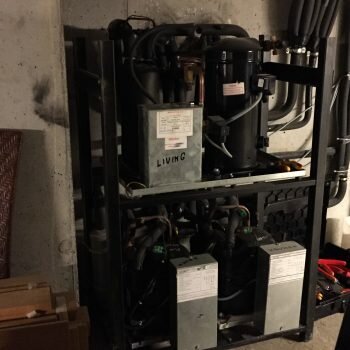This photo gives an overview on how Actility tracks the houses in Oud Heverlee and what’s installed yet in each house.
Case study 2
The goal of the second demonstration case is to bring 13 houses in Oud-Heverlee off-grid by creating a microgrid at the end of the distribution line. The aim is to demonstrate the synergy of a neighbourhood strategy for flexibility and grid balancing. In order to accomplish this, everything in the neighborhood that can store energy needs to be monitored. This ranges from the temperatures of heat storages and buildings to the state of charge of a battery. Furthermore, a centralized system needs to be able to control all the flexible devices that can shift their electricity consumption.
Through the LoRa network, Actility provides an extremely simple solution to monitor and control all these different devices. LoRa is a long range low power network to which sensors can immediately connect and start sending data or receiving control signals.
Demonstration at residential neighbourhood scale
This demonstration is all about technology that should change the energy consumption of the people, while they should ideally not even sense this technology. The aim is to demonstrate the synergy of a neighbourhood strategy for flexibility and grid balancing. A flexible smart control is implemented that allows testing a wide range of business models.
Oud-Heverlee, Belgium
The technological solutions that bring flexibility to households have been installed in the previous phase. Those residential buildings that have a heat pump with floor heating or a hot water boiler, either for domestic hot water or for house heating, can apply intelligent control strategies for load shifting. Others have limited load shifting potential concerning their normal daily energy use. During the course of the project, 3 e-cars are added to the test case. The overall storage capacity, either thermal or electrical, combined with the local production through solar energy systems and fuel cells, allows to offer a considerable amount of flexibility to the grid.
A LoRa basestation is setup near the demonstration site in Oud Heverlee to connect all sensors and devices to the internet . This basestation will receive all monitoring data such as temperatures, voltages and more and will safely send it over the internet to the Thingpark Cloud platform at Actility headquarters where all data is stored and analyzed.
In a second step, all sensors will be installed in the houses to measure the power, voltages, temperatures and more. Due to LoRa as the single communication technology and gateway through which all devices are able to connect in an area of more then 2 km for each basestation, Actility ensures easy interoperability between all devices connected to the network!
After a detailed analysis of the flexibility and the development of sophisticated control algorithms by the STORY consortium, Actility will ensure the correct control signals are send to all devices over the LoRa network. With it’s knowledge of both IOT and the energy markets Actility is able to greatly contribute to bringing the excellent developments of STORY into practice in this demonstration case.
In cooperation with the local distribution operator, a wide range of potential business models is tested. The evaluation of their outcome focusses on both the reduction of losses as well as in the creation of a win-win-win for all stakeholders involved.
Once the neighbours are well aware of the potential of a micro-grid, it is up to them to express how they would like to see it organized, how far they are willing to change their behaviour, … That strategy that is extracted from their suggestions and demands is the last strategy that will be implemented.
Responsible partners: ACTILITY & THINK E
“We see this demonstration as an ideal showcase of the synergy between the energy and IOT fields and would like to show how ICT can be an effective enabler instead of a nuisance to STORY.“
Arnout Aertgeerts, Actility

Overview of the houses in Oud Heverlee

The installation of the local onsite LoRa base station
A special long antenna was placed on the top of one of the houses participating (Think-E add-on building a bit higher in landscape).
The LoRa base station was connected via Ethernet onto the Internet, so that all the sensor data can be forwarded to central application platforms.

Analysis of the monitoring data
We also performed Spectrum Scans on the OHL site as to verify the status & quality of the spectrum, as the LoRa technology is making use of a shared public spectrum at 868Mhz.

Graphic Temperature
The Data Logger website, where we are able to see the Temperature (black line) and the Humidity (blue line).

Graphic Heat Pump
Graphic that explains the limits in which to use the Heat Pump.

LoRa SmartLog
In house 4, the LoRa SmartLog device provides 3 temperatures thanks to 3
temperature sensors installed on the top, middle and bottom of the Heat
Pump Boiler.











